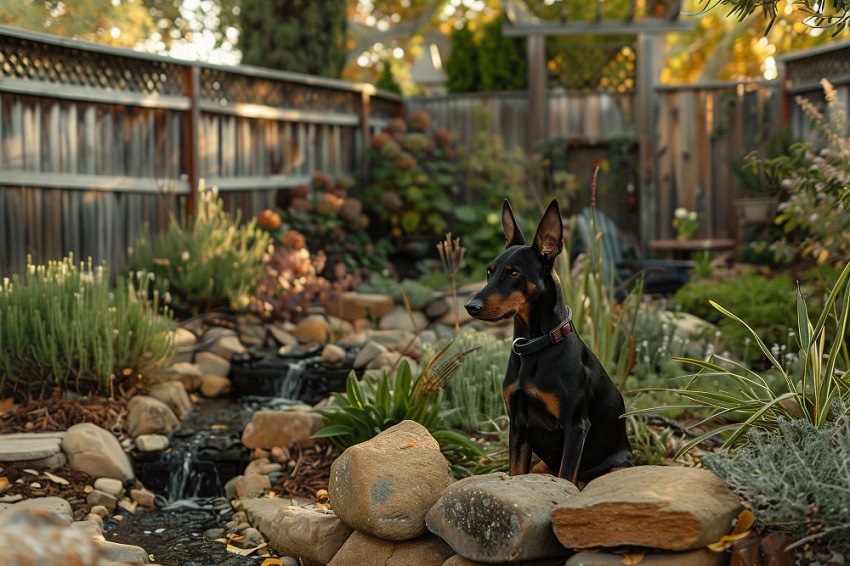Owning a dog is common in most homes in the United States, but a strong and reliable fence is essential to keep the dog safe and prevent disturbing neighbors. The following 10 types of fences are the most popular and proven to work in the United States. Each type can be selected based on HOA regulations, local laws, and the breed of dog.
Best Types of Fences for Dogs
1. Chain-Link Fence
It is the cheapest and most commonly used fence in the United States. It’s made of steel mesh.
Advantages: Dogs can’t escape, you can see inside and out, and air easily passes through. 6 feet high with an L-shaped extension (dig guard) at the bottom, preventing even digging dogs from escaping.
Cost: $15–$30 per foot. Very durable, lasts 20–30 years.
2. Wooden Privacy Fence (Stockade or Shadowbox)
It is a completely enclosed wooden fence, 6-8 feet high, with no gaps.
Advantage: The dog doesn’t bark at outside objects and is less likely to try to escape. Best for large, jumping dogs (like Labradors and German Shepherds).
Tip: Be sure to install a kickboard at the bottom and a top rail at the top.
3. Vinyl/PVC Fence (Vinyl Privacy Fence)
Vinyl fence is a completely enclosed plastic fence, looks like wood but doesn’t rot.
Advantage: Never needs to be painted, can’t cause damage even if chewed on, and lasts 30-40 years. It’s very popular in both hot and cold regions of the US.
Slightly higher cost ($25-$50 per foot) but excellent lifetime value.
4. Ornamental Aluminum Dog Fence
Ornamental aluminum dog fence is a beautiful black wrought-iron fence, 4-6 feet high and best for puppies and small-medium dogs.
Advantages: Rust-resistant, even jumping dogs can’t get through (spear tops). Most preferred in areas with HOAs.
5. Steel Ornamental Fence (Wrought Iron / Steel – Stronger Version)
Steel ornamental fence is stronger than aluminum, perfect for large and aggressive dogs (Pitbulls, Rottweilers).
Advantage: Almost impossible to break or bend.
6. Split-Rail Fence + Wire Mesh Combination (Split Rail with Wire Mesh)
It’s a village-style wooden fence with 2-3 rails, lined with chain-link or hardware cloth (mesh with 1/2-inch holes).
Advantage: Affordable and elegant, even small dogs and rabbits can’t escape. Very common in rural and suburban areas of the US.
7. No-Climb Horse Fence + Top Rail (Horse Fence / No-Climb Wire)
Strong wire mesh with 2″x4″ holes. Best for large dogs that can climb chain-link.
Advantage: No feet get stuck, impossible to climb. Adding wooden or PVC rails on top makes it stronger.
8. Invisible/Underground Electric Fence (Invisible Dog Fence)
Invisible Dog Fence Works by laying a wire underground and attaching a shock collar to the dog’s neck.
Advantage: Nothing visible from the outside, best in areas with HOAs. With proper training, 95% of dogs don’t cross the boundary.
Note: Sometimes less effective on larger and stubborn dogs.
9. Palisade Fence (Palisade / Dog-Eared Picket with Small Gap)
It is a wood or vinyl fence with sharp points on top. Very small gap (1-2 inches).
Advantage: Small and medium dogs can’t even stick their noses out. Both decorative and secure.
10. Combination Fence (6 feet privacy + 1-2 feet lattice top)
6 feet completely enclosed wood or vinyl at the bottom, 1-2 feet of lattice or extension at the top.
Advantage: 7-8 feet of height is available, even very large jumper dogs (like Malinois and Border Collies) can’t jump.
Best advice (in brief):
- Small dogs (Yogi, Chihuahua) → Keep the gap less than 2 inches.
- Large and jumper dogs → At least 6 feet, preferably 7-8 feet.
- Digger dogs → Install concrete or L-footers 1-2 feet below.
- Aggressive or escaping dogs → Choose a physical fence (chain-link, wood, vinyl); rely less on invisible ones.
These 10 types of fences have been working in millions of homes in the US for years. Choose based on your needs, budget, and local regulations – your dog will be happy, your neighbors will be happy!


